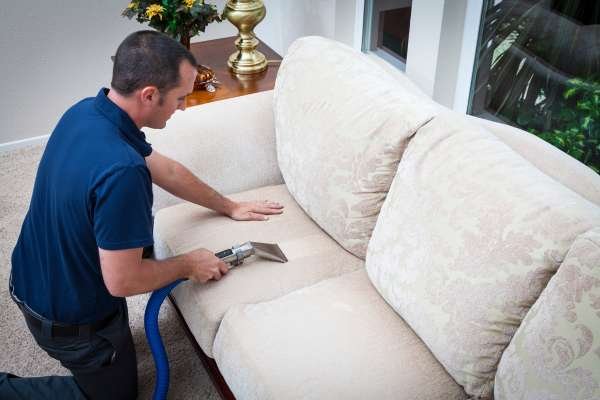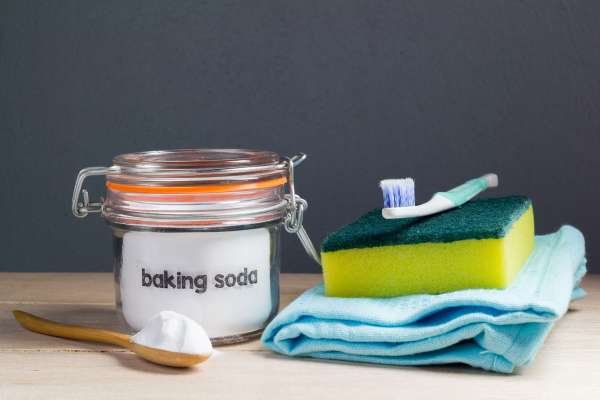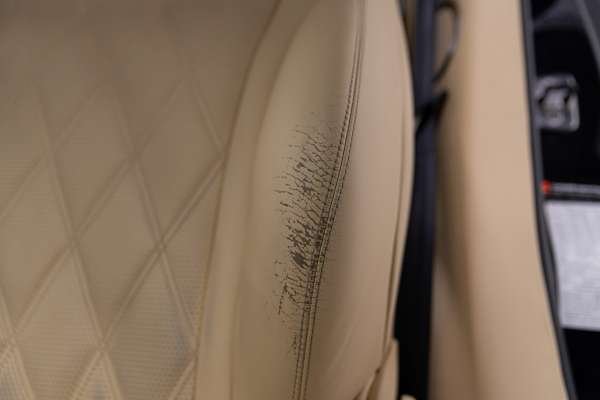Maintaining the pristine appearance of a white leather sofa requires regular cleaning, a crucial aspect of furniture care often overlooked. Over time, white leather can easily show signs of wear, discoloration, and stains, detracting from its luxurious appeal. However, with the right approach, restoring and preserving the sofa’s elegant look is straightforward. Among the various cleaning agents available, baking soda stands out for its gentle yet effective cleaning properties. This household staple is not only affordable but also eco-friendly, making it an ideal choice for those conscious of their environmental impact. Utilizing sodium bicarbonate in the cleaning regimen ensures the white skin sofa remains spotless without risking damage to its delicate surface. The following guide provides a simple and efficient method to clean your white leather sofa using baking soda, ensuring it continues to enhance your living space with its unblemished beauty.
Preparing the Sofa

To prepare a white leather sofa for cleaning with baking soda, start by thoroughly vacuuming the sofa to remove any loose dirt and debris. Use a soft brush attachment to avoid scratching the skin. Pay special attention to crevices, seams, and under the cushions where dust and crumbs can accumulate. Next, gently wipe the leather surface with a clean, dry microfiber cloth to remove any lingering dust. It’s crucial to ensure the sofa is completely dry before applying the sodium bicarbonate solution to avoid water stains on the leather. Properly preparing the sofa ensures that baking soda can effectively tackle surface stains without any hindrance from dirt and debris, thereby enhancing the efficiency and security of the cleaning process. This preparation step is essential for maintaining the integrity of the skin while ensuring a deep clean.
Cleaning Process

Cleaning a white leather sofa can be a delicate task, but with baking soda, you can effectively and safely maintain its pristine look. Start by vacuuming the sofa with a brush attachment to remove loose dirt. In a small bowl, mix a solution of one part sodium bicarbonate with two parts water to form a paste. Test the paste on an inconspicuous area of the sofa to ensure it doesn’t cause discoloration. Gently apply the paste to stains or dirty areas using a soft cloth, using circular motions to lift the dirt. Avoid using too much pressure to prevent damaging the leather. Treat the area, then wipe off the paste with a damp cloth, followed by a dry cloth, to remove any moisture. For best results, treat your sofa with a skin conditioner after cleaning to keep it soft and prevent cracks. This simple method helps keep your white leather sofa looking as good as new.
Baking Soda Cleaning Solution

To maintain the pristine condition of a white leather sofa, use a baking soda solution. Tanned material has a delicate surface. To prepare the solution, mix one part sodium bicarbonate with two parts water to create a paste. Apply the paste sparingly to the stained or odorous areas using a soft cloth, ensuring gentle circular motions to avoid scratching the leather. Allow the solution to sit for a few minutes, then use a damp cloth to wipe it off, followed by a dry cloth to eliminate any remaining moisture. This method not only cleans but also maintains the sofa’s integrity, ensuring it remains a stylish and comfortable centerpiece in your home. Always conduct a spot test in an inconspicuous area before applying widely.
Why Choose Baking Soda

Baking soda, a staple kitchen ingredient, emerges as an outstanding choice for cleaning white leather sofas due to its gentle yet effective cleaning properties. Its natural, non-abrasive nature ensures that the delicate tanned material surface is not damaged during the cleaning process. Unlike harsh chemical cleaners that may strip the leather of its natural oils,sodium bicarbonate maintains the integrity and luster of the skin while effectively lifting stains and neutralizing odors. Its absorbent properties make it exceptionally good at removing oily stains and absorbing moisture without leaving residue. Moreover, baking soda is eco-friendly, ensuring that your cleaning routine does not contribute to environmental pollution. Opting for baking soda is also cost-effective; it offers a high-quality cleaning solution at a fraction of the price of specialized leather cleaners. In addition, its hypoallergenic properties make it safe for households with pets and children, providing a non-toxic alternative for maintaining the pristine appearance of white leather sofas. Choosing sodium bicarbonate is a smart, sustainable, and safe method to keep your white furniture looking its best.
Will baking soda damage leather?
Baking soda, a common household staple, is celebrated for its versatility in cleaning, including its use on white leather sofas. Its natural, mild abrasive properties effectively lift dirt and absorb oil stains without damaging the -skinned, when used correctly. However, it’s crucial to exercise caution. Baking soda should be applied sparingly, as overuse can lead to drying out the skin, potentially causing cracks over time. For a safe cleaning method, lightly sprinkle sodium bicarbonate on the stained area, let it sit for a few minutes to absorb the oils, then gently brush it off with a soft, clean cloth. Always perform a spot test on a hidden area first to ensure it doesn’t affect the leather’s color or finish. Regularly conditioning the skin after cleaning ensures its longevity, keeping your white leather sofa looking pristine.
How to Clean White Leather Sofa With Baking Soda: Is baking soda safe for leather?
Baking soda, a common household staple, is renowned for its versatility and is frequently recommended as a gentle cleaning solution for various surfaces, including white leather sofas. However, caution should be exercised. While sodium bicarbonate can effectively remove light stains and odors due to its natural absorbency and mild abrasive qualities, it is imperative to use it correctly to prevent damage to the skin. To safely clean your white leather sofa with baking soda, sprinkle a small amount on the stained area, then gently rub it in using a damp cloth. Avoid excessive rubbing, and ensure the cloth is only lightly moistened to prevent water damage. Afterward, wipe off the residue with a clean, dry cloth. Before applying this method to visible areas, it’s advisable to test it on a small, inconspicuous section of the sofa. Regular conditioning after cleaning is also recommended to maintain the leather’s suppleness and prevent drying or cracking.
How to Clean White Leather Sofa With Baking Soda: Can vinegar damage leather?

Vinegar is a widely used natural cleaner, appreciated for its ability to cut through grime and neutralize odors. However, when it comes to cleaning leather, especially white leather sofas, caution is paramount. The acidic nature of vinegar can potentially damage skin surfaces, causing them to dry out and crack over time. While diluted vinegar can be used sparingly for tough stains, its application must be carefully managed. To minimize risk, it’s advisable to mix vinegar with water in a 1:1 ratio and apply it sparingly with a soft cloth, immediately following up with a clean, damp cloth to remove any vinegar residue. Afterward, drying the area thoroughly and applying a leather conditioner is crucial to restoring moisture and protecting the skin. Given the potential risks, testing this cleaning method on a small, hidden area of the sofa before widespread application is recommended to ensure it does not harm the leather.
Can I clean my leather sofa with baby wipes?

Using baby wipes to clean a white leather sofa may seem convenient, but caution is advised. While baby wipes are gentle on the skin, their chemical composition can be harmful to skin surfaces. These wipes often contain ingredients that can degrade leather’s protective finish over time, leading to dryness, cracking, and discoloration. For maintaining the pristine condition of your white leather sofa, it’s better to opt for cleaning methods specifically recommended for skin. Wipe the surface gently with a soft, damp cloth, and then use a dry cloth to remove any moisture as a safe alternative. For deeper cleaning, consider a solution of mild soap and water, applying sparingly with a soft cloth. Always finish by applying a skin conditioner to keep the sofa supple and prevent drying out. If in doubt, consulting the sofa’s care instructions or a professional leather cleaner is always the best course of action to avoid accidental damage.
Maintenance Tips
Maintaining a white leather sofa’s pristine appearance involves regular care and gentle cleaning methods. Baking soda, a non-abrasive, natural cleaner, is highly effective for this purpose. To keep your sofa looking its best, follow these maintenance tips. Firstly, vacuum the sofa using a soft brush attachment to remove loose dirt and debris. For spot cleaning, create a paste of baking soda and water, apply it to stains, and allow it to sit for a few minutes before gently wiping away with a damp cloth. This method is particularly effective for removing grease and oil stains without damaging the skin. After cleaning, always dry the surface thoroughly with a soft, lint-free cloth. To prevent future stains and keep the leather supple, apply a skin conditioner after cleaning, following the product’s instructions. Additionally, avoid direct sunlight and heat sources to prevent fading and cracking. Regular care using these simple tips will ensure your white leather sofa remains a stylish and inviting centerpiece in your home.
How to Clean White Leather Sofa With Baking Soda:Conclusion
Baking soda emerges as a viable, eco-friendly solution for tackling light stains and odors on white leather sofas. Its mild abrasive nature and absorbent properties make it a gentle yet effective cleaner when used judiciously. However, the key to harnessing its benefits without risking damage lies in its careful application. Revitalize your sofa and preserve its integrity by sprinkling a small amount of sodium bicarbonate on stains. Gently rub it in with a soft, damp cloth, and conclude the process by using a clean, dry cloth to remove any residue. Importantly, conducting a spot test on a hidden area ensures safety, preventing potential discoloration or damage. Regular maintenance, including conditioning after cleaning, further protects the leather, ensuring its longevity and beauty. Embracing baking soda for cleaning tasks reflects a sustainable choice, marrying effectiveness with environmental consciousness. Nevertheless, for persistent stains or doubts about the sofa’s material, consulting a professional cleaner is advisable to ensure the best care for your cherished furniture.
